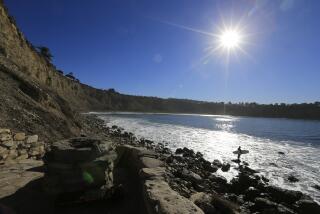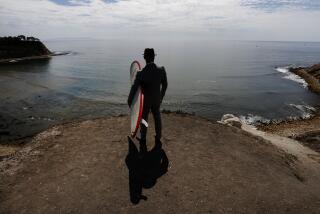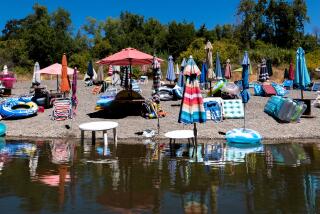South County Surfers Defend Home of the Waves
- Share via
SAN CLEMENTE — It’s not often that Ryan Molencamp gets a day off from his job but when he does, the 22-year-old Vista construction worker enjoys driving to T-Street beach here, Molencamp’s favorite Orange County beach.
“I used to come to this beach as a kid,” Molencamp said while munching pizza as he sat on a bluff above the sandy beach. “I love it here, it’s got a different feel to it, you know? It’s not crowded and it’s a beautiful beach.”
Many surfers agree. T-Street, named after nearby Trafalgar Street and located about a quarter mile south of the city pier, is where young surfers such as C.J. Drummy, a 10-year-old, can dream of becoming surfing’s next champion, and where Geoff Whisner, a strapping 20-year-old dubbed “Big Red” because of his red locks, can carve Cropley’s, one of T-Street’s three main breaks.
“Hey, parking’s easy, and it’s a challenging enough [beach] break to make it fun,” Whisner said. “It’s fickle here, but it’s consistent.”
Let surfers overpopulate the waters in north Orange County and fight for waves at the pier in Huntington Beach. You want heavy vibe? Surf Salt Creek. Purists? Let ‘em drive down to Trestles and trek in.
And, despite its fickleness, this is T-Street, home port to what many claim is the breeding ground for some of the best surfers anywhere. With surfing roots that go back to the days of Jeff “Midget” Smith, Hobie Alter, Phil Edwards and Mickey Munoz, many believe San Clemente rather than that place up north has a more legitimate claim to the title “Surf City.”
“I always kind of smile when I see Huntington Beach being called Surf City,” said Sam Conroy, former San Clemente High School surfing coach who retired in 1991. “There was a time where if you looked at the roster of professional surfers, there were more from San Clemente than Huntington Beach.”
With a wry grin, Conroy added: “In the early days, we joined the same league as Huntington Beach High School, we won nine of 11 state championships.”
According to surf archivist, Ann Beasley at the Huntington Beach International Surfing Museum, Hawaiian surf legend Duke Kahanamoku trained for the Olympics in swimming at the town pool as early as 1910.
“Of course it’s just conjecture that [Kahanamoku] surfed there in San Clemente too,” Beasley said. “We do know that he surfed at Corona del Mar, where he kept a board there.”
Among local surfers who have carved their niche at T-Street is Jim Hogan, 31, part of T-Street and San Clemente’s second generation of professional surfers.
“Our history here goes deep,” said Hogan, now a father of two who hones his long boarding skills at T-Street’s Main Break. “We’ve got Tom Morey, Dale Velzy, the Fletcher family and people such as Matt Archbold, the Beschens and Dino Andino. I mean, when you talk about people surfing T-Street and coming out of here top surfers, it’s pretty thick.”
The break has produced at least three U.S. professional champions, including Andino, Mike Parsons and Shane Beschen, who consistently is among the top five of the world tour.
*
T-Street has a wide sandy, clean beach, swings for children, outdoor showers, a concession stand for snacks during summer months and metered parking.
Among old schoolers, Munoz stands out among the best. At 59, Munoz still kicks it with the short boarders and youngsters such as Justin Hill, 17, captain of his high school body board team, who whips 360s as easily as tying his shoes.
Munoz, who used to be a lifeguard at T-Street, recalls the ocean water once was so pristine they encountered unusual sea life.
“I remember one time that killer whales came through inside of Seal Rock and they were hassling the seals there,” Munoz said. “There were about half a dozen and they kind of swam through the area here. We had swimmers in the shore break and one surfer out in the water about 100 yards from shore.”
Munoz said he and the only other lifeguard stared at one another hoping the other guard would volunteer to bring the surfer in. They didn’t. Each just stood there silent.
“It’s funny now,” Munoz said. “It wasn’t funny then.”
Eventually they cleared the water without having to swim after the lone surfer.
San Clemente High surfing Coach Bill Hartman can recall when he first started surfing there in the ‘60s. In those days, the best beaches were Big Corona, Killer Dana and San Onofre.
“T-Street was always uncrowded,” Hartman said. “In the 1970s they had a merry-go-round next to where the swings are and it was a great family beach. Yet, Dad could go out and surf and have a good time.”
But as the city grew, so did the number of surfers and bodyboarders. “In those days surfers were real water people, you know, the kind who lived at the beach,” Conroy said. “You didn’t see surfers coming from inland so much. But then [the movie] ‘Endless Summer’ came out and people came from Kansas to surf.”
Clashes were bound to occur. And they did. Arguments about water turf erupted, sometimes ending in fisticuffs on the sand.
To alleviate the problem, Smith urged the City Council in the 1970s to have a “leash only” beach, which would prevent dangerous loose boards from striking anyone.
Instead, the city continued allowing surfers on one peak and body boarders on another until it was necessary to initiate a black ball in 1982.
“As the crowd increased in both sports, it created far too many problems with surfers mainly going into the other’s areas,” said Lt. Bill Humphreys of the city Marine Safety Department. “Especially with strong south swells it was physically impossible to stay within boundaries.”
Humphreys recalled a historic meeting when both groups sent representatives to a city Recreation Commission meeting to hack out a truce.
“It was decided to give surfers the mornings and late afternoons,” he said. “As a trade-off, middle of the day to 6 p.m. would be exclusively for swimmers and body boarders,”
Nowadays local T-Streeters such as Whisner and body boarders such as Hill seem to have reached a peaceful accord. Whisner added, that as long as you give respect to others in the water, “you’ll be treated with respect.”


